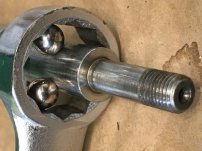I was doing a bearing change on my tool post grinder spindle and noticed 2) small drill spot on the shaft. Intuitively I knew what it was for but cant remember where I leaned about this technique and wanted to research it a little because it works so well. Has anyone ever seen this written up or know more about it orign?
Thx
Rob


Thx
Rob



